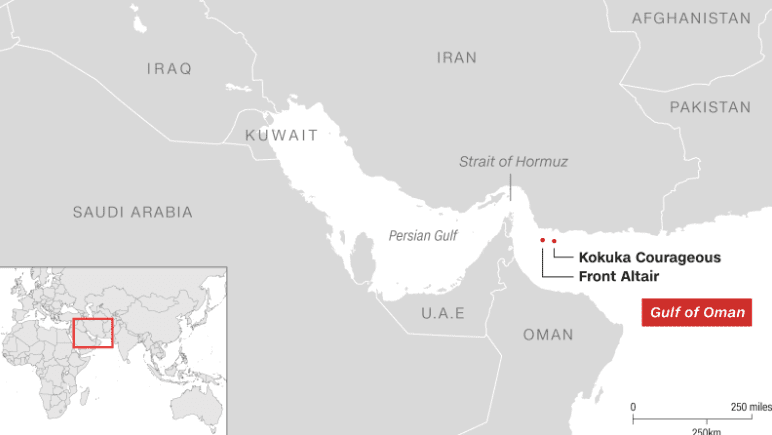What the Gulf Tanker Attacks Mean for Oil and Gas Prices

Yes,
US oil prices jumped — initially climbing as much as 4.5% before retreating a
bit — but they didn't skyrocket. They currently sit near five-month lows
despite the fact that the tankers were attacked near the Strait of Hormuz, the
most important chokepoint for oil transit on the planet.
The
relatively muted reaction shows what's really driving the oil market right now:
signs of deteriorating demand caused by the elevated trade tensions and slowing
global economic growth.
In
other words, the ongoing trade war is trumping the threat of a potential
shooting war — for now, at least.
"The
rally is not particularly impressive. In other years, this would be a 5% to 10%
move," said Tom Kloza, global head of energy analysis at the Oil Price
Information Services.
Even
taking into account Thursday's jump, US oil prices remain in a tailspin.
They've collapsed about 20% since hitting $66.30 a barrel in late April. Brent
crude, the global benchmark, is down nearly as much.
And
that oil plunge has yet to filter through to retail gasoline prices, which move
with a lag.
"Unless
there's something really, really dramatic that happens in the Strait of
Hormuz," Kloza said, "the consumer will see lower prices."
Retail
gas prices have already dropped by 17 cents from the 2019 high to $2.72 a
gallon, according to AAA. Expect further declines to come.
Security
fears ratchet higher
Still,
the situation in the Middle East remains serious, for oil prices and the world.
The
brazen attack in the Gulf of Oman comes against the backdrop of heightened
tensions between the United States and Iran.
"The
risk that escalation could get out of hand is not insignificant," said
Jason Bordoff, a former energy adviser in the Obama administration who now
leads Columbia University's Center on Global Energy Policy.
About
22.5 million barrels of oil passed through the Strait of Hormuz each day since
the start of 2018, according to energy analytics firm Vortexa. That's roughly
equivalent to 24% of the world's daily oil production.
The
incident comes after four oil tankers were attacked last month off the coast of
the United Arab Emirates. Saudi Arabia also reported armed drone attacks last
month on a pair of pumping stations in the kingdom.
"This
brings up the specter of a tanker war situation," said Helima Croft, a
former CIA analyst who is now RBC Capital's global head of commodity strategy.
Demand
destruction is the focus
But
oil prices still haven't taken off. In fact, crude didn't even recover the 4%
loss it took on Wednesday.
"It's
pretty remarkable," said Croft. "We've now had six tankers struck,
the Saudi airport hit and more sanctions coming on Venezuela — and oil still
can't get a bid. It just shows you the strength of the bearish sentiment."
Normally,
Croft said, the combination of all those events would suggest a Brent oil price
close to $100, instead of $62.
The
negativity is being driven in part by a spike in oil stockpiles in the United
States, a likely indication of weak demand caused by the slowing global economy
and escalating trade war.
US
oil inventories climbed by another 2.2 million barrels last week, leaving them
about 8% above the five-year average for this time of the year, according to
the US Energy Information Administration.
OPEC
on Thursday slightly downgraded its 2019 global oil demand outlook, pointing to
"sluggish" demand from developed nations.
Blockbuster
US oil growth
Although
OPEC had been under pressure to ramp up production earlier this month, the
cartel is now widely expected to keep output steady — or even cut it.
The
bearish mood in the oil market is noteworthy given recent OPEC supply
disruptions. The Trump administration's sanctions on Venezuela have wiped out
the South American nation's crude shipments to the United States. And Iran's
oil exports have also been sidelined by US sanctions.
But
those OPEC barrels have been offset by incredible production in the United
States, led by the Permian Basin in West Texas. US output is on track to spike
to a record 13.4 million barrels per day by the end of 2019, according to
research firm Rystad Energy.
Is
the market underestimating the risk in the Middle East?
The
oil market could yet be awakened from its slumber if the United States and
China reach a trade agreement — or if the security threat in the Middle East
worsens dramatically.
A
direct US-Iran conflict, or a shutdown of the Strait of Hormuz, remain
"long shots" due to Iran's fear of US military action and the US
administration's aversion to foreign entanglements, Paul Sheldon, chief
geopolitical advisor at S&P Global Platts Analytics, wrote in a note
emailed to CNN Business on Thursday.
"But
the risk of miscalculation in the Middle East is clearly rising," Sheldon
wrote.
In
other words, both sides don't have to want a conflict for one to emerge.
Croft
argued that oil prices are not "in any way reflecting the reality of the
situation in the region."
"We may be in a very, very serious security crisis before the market realizes it," she said.
